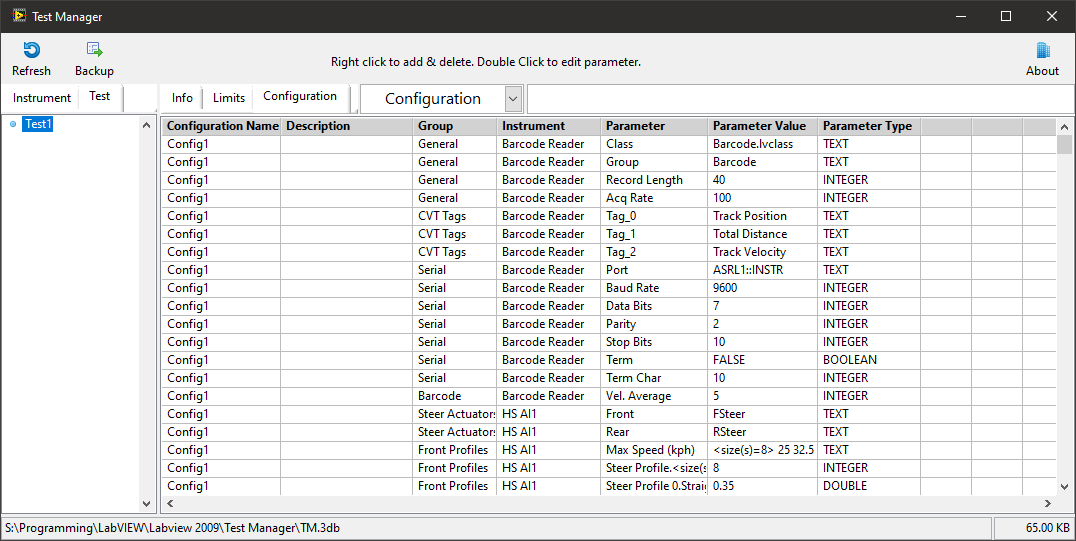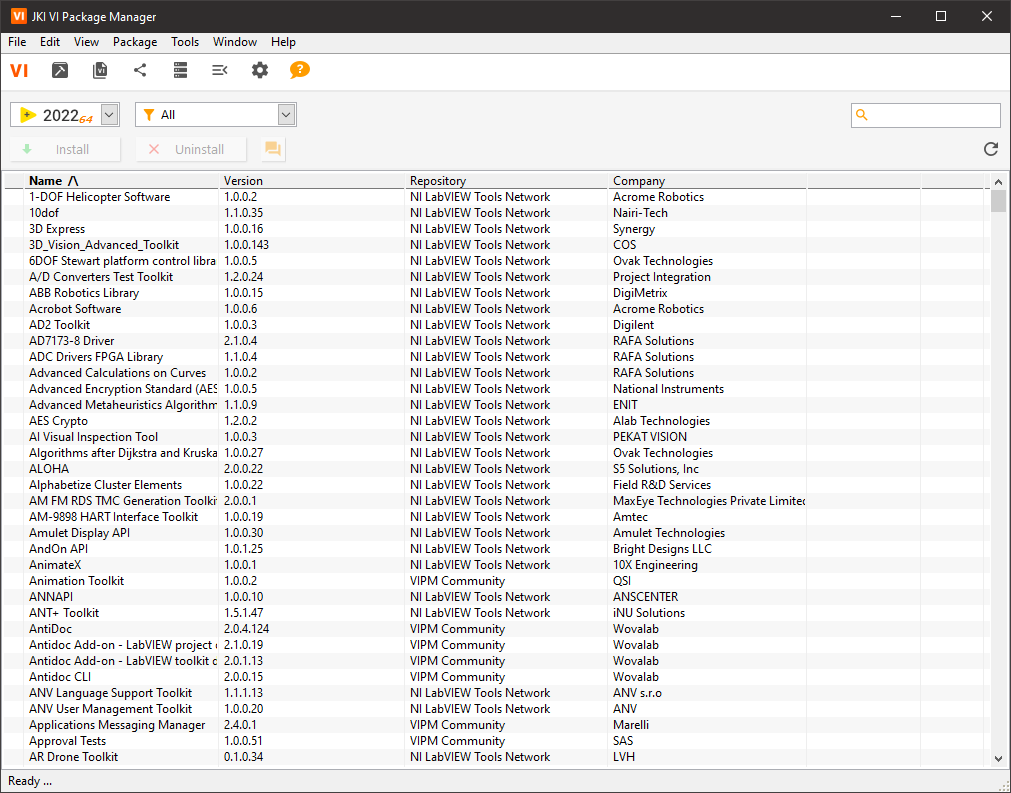-
Posts
4,990 -
Joined
-
Days Won
311
Content Type
Profiles
Forums
Downloads
Gallery
Everything posted by ShaunR
-
Back at around version 2 Linux and Mac were supported but only Windows was distributed (see licensing below). Linux was a real pain to maintain so I dropped that. No one was interested in Mac so I dropped that too. There are several reasons why Linux support is unlikely in the future: The NI licencing scheme only works on Windows. There is quite a lot of Windows specific stuff now like the use of the Windows Certificate Store and Windows Messaging for ICMP (off the top of my head-but there's more). Linux is a real pain to maintain for. (50% chance of any one distribution of any software working out-of-the-box). LabVIEW may be synonymous with the Dodo in the next year or two. 1. Has a solution but I'm tentative. 2. Is doable with a quite some of effort. 3 just isn't worth the aggro and 4. Well. Interesting times. There are lots of reasons why *not*. Very few of why it should.
-
Tada! Just released 4.3.0 with MQTT support (and, of course, examples). Have fun!
-
Eric Starkloff horse trades NI shares. The ones we are really interested in are the 50+% owned by the creators and their families. I still have a feeling all these "Over by March/April" are a kind of propaganda. NI's behaviour doesn't seem to be of a company about to throw in the towel-quite the contrary. I'm still quietly hopeful it will all fall through but hey! I'm a programmer! What do I know about this stuff anyway?
-
Just mention GOOP 3 times and it will summon MikaelH - who can tell you everything about it.
-
Aha! Yes. Apologies.
-
As you are the only one that has commented on it al all (indirectly). I think that's a resounding "don't bother". Also means I don't have to look too closely at DTLS just yet
-
So. that's a resounding "don't bother" on the CoAP then
-
If Emerson buy NI, you can look forward to no LabVIEW at all.
-
Here is a List API. Seems complicated but it's a "managed" list with lots of features. Overkill for what you need but it demonstrates a point. You could use it for your data but then you'd have a dependency. I'm guessing you don't want dependencies at this point. You'll notice it has two items in the cluster - Name and Variant (variant is a general type and think of it as your Cluster). The important part is that it has a "Name". This is a poor replacement for the Cluster Name (functionally) but it does enable lookups, even by regular expressions. It serves a very similar purpose but operates at run-time instead of design time The name is just a string label. It can be anything. Granted it's not as simple as an enum but it does give much more flexibility and doesn't require design time editing of the control to make changes. The tradeoff is complexity. Now you have a way of making a list behave like a database but you need specific functions to look up and return data. This, from one of the list examples, returns all items with a numerical label: Intuitively you will realise that having duplicate data is not very useful unless you can distinguish between the original and manipulated. Up until now you have used the Cluster with an unbundle which has served you well but are now finding that you need to edit the cluster every time you add new variant of your data. The label gives you that ability at run-time instead of design time with a small increase in complexity. However. Your biggest issue is compartmentalization - separating config from data. Now. What if only the List (aka data array) wasn't tied to a particular data type? Then, by thinking carefully about the labels you use, you would be able to differentiate between the different data types, different devices and different configs There are other ways to approach this. But from where you are at present I would suggest this way - at least until you are more confident with your abilities. The database I suggested earlier requires a different mind-set and classes are a huge learning curve. This is a modest step from where you are to where you want to be.
-
If you are going they way I think you are, all you will do is swap [un]bundles for VI's and add a lot of boiler plate. To be fair. You monster cluster isn't really that much of a monster-more like a tribble. My advice (if you're not going to re-architect) would be just to split out the data from the config. Your All Scan data BG and HRS is actually an identical format so you could rationalise that into a single array which will make adding more of the same format easier (just add and index into the array-no need to modify the cluster to add more data). Everything else seems to be config data.
-
Break down your complex and complicated data types into a complex and complicated architecture. FTFY
-
-
Last time I looked it was about 1.1.1e. I don't think it was much better. I bypassed it in the end because it needed callbacks for cookies-wasn't prepared to do that at the time. I'm hoping they've moved on from there with full blown certificate verification but if they haven't, I now have a place for callbacks in the API.
-
source I guess you don't have the Full or Professional LabVIEW?
-
Building the protocol from scratch isn't a barrier for me - I'm on a roll The difficulty is that it requires DTLS (the UDP version of TLS). DTLS is something I've played with in the past and it was somewhat awkward to integrate into what I have currently so I moved past it and on to other features that I desperately wanted. CoAP would force me to look at DTLS again as it is something I've wanted, but never had a need for. IMO CoAP is a far superior protocol to MQTT. I don't really understand why MQTT gets so much love.
-
Anyone interested in CoAP?
-

Request for LabVIEW Block Diagrams for Dataset Collection
ShaunR replied to Elbek Keskinoglu's topic in LabVIEW General
I think you need to do some LabVIEW courses and/or tutorials. You're clearly are out of your depth here with even the concept of what LabVIEW is and how it operates at the most basic level - you have bitten off more than you can chew. Go and ask ChatGPT how to make a LabVIEW program to add two numbers and you will see the difficulties you face. -
That works. Thanks.
-
Interesting. Not the sort of behaviour of a company that's about to roll over.
-
English *is* my first language and I'm not as eloquent as you are. There is no real argument here, though. I still use LabVIEW 2009 for development because there is little that the later versions offered of significance. It's also robust, stable and fast. That cannot always be said for some of the later versions (looking at you 2011/2012). Some features that actually got us excited weren't even on the roadmap (VIM's anyone?). NI have been so far behind the curve for features that we want that we have all created our own solutions so if one of them actually gets implemented, it's a moot feature. TLS/SSL, for example was only released in LV2020 but I (and Rolf) had created solutions a decade before that. The one thing we have been yelling at NI about for about 15 years is Unicode which we cannot really make a native solution for. This is why I laughed when it was mentioned in this talk. I moved to HTML UI's and relegated LabVIEW to a back-end service through Websockets which solved the problem but it's a sledgehammer to crack a nut.
-
I don't think anyone is saying that, so much, with respect to NI as a whole. But the effort and investment in NXG made LabVIEW (Classic?) the withered limb of NI, Now they have lots of C# devs who can't do jack with LabVIEW. From this seminar, it looks like this is a solution (lots of C# devs) looking for a problem (Cloudy stuff) and they see LabVIEW as a stagnant technology instead of the axiomatic driver behind their hardware it actually is. Don't get me wrong. They can very easily move into this space and do all the cloudy stuff. But their view of how this will fit together is flawed (IMO). They are viewing it purely like an IT system rolling out images (think AWS Compute-IAAS) when, in fact, those images will be highly specialised LabVIEW installations for very specific and usually custom hardware configurations. They lost Test and Measurement to Python a while ago-arguably the mainstay for LabVIEW.
-

Request for LabVIEW Block Diagrams for Dataset Collection
ShaunR replied to Elbek Keskinoglu's topic in LabVIEW General
I've really no idea what this means. If you are just looking for a volume of any code then VIPM has hundreds of libraries (with source) that you can train on. You will have 10's of thousand of VI's with source to point your algorithm at. Apart from that, you will have to be more specific. Artificial Insemination is coming for us, boys and girls. -

Request for LabVIEW Block Diagrams for Dataset Collection
ShaunR replied to Elbek Keskinoglu's topic in LabVIEW General
You'll need to define exactly what "experimental setups" means - I've no idea -

Including solicitation of interest from potential acquirers
ShaunR replied to gleichman's topic in LAVA Lounge
-
Chasing the golden geese, it seems. Interesting stuff throughout but the real juice is at about 55mins in the "Distribution of Resources". (Spoiler, it's a small club and we aint in it). The mention of porting Unicode made me laugh heartily though . My final takeaway was too many C# coders left over from NXG.








